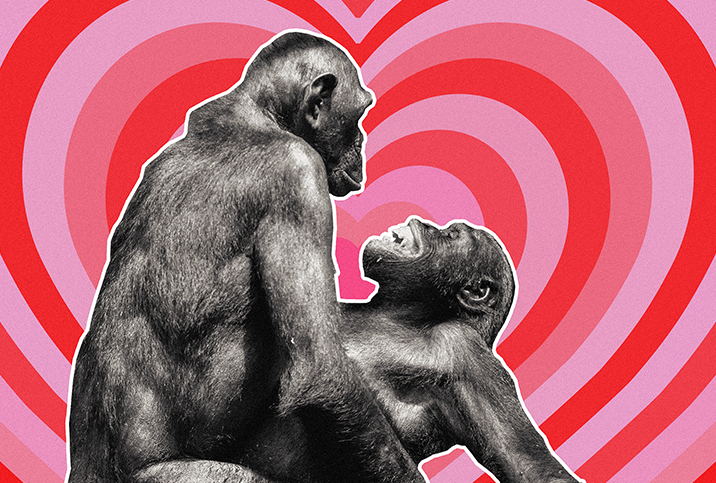The Deep, Evolutionary History of Monogamy

While traveling through the highlands of Papua New Guinea, biological anthropologist Helen Fisher, Ph.D., met a man with three wives.
The three wives didn't faze Fisher. Polygamy—the practice of marrying multiple spouses—has been permitted in PNG's mountainous region for generations, provided a husband can cover the increasingly hefty going bride price of livestock, shells and cash.
Instead, what struck Fisher was the man's answer to her question, "How many wives would you like to have?"
Half-expecting him to say, "10" or "25," she was surprised when the man instead responded, "None."
"And the reason he said none is because [having multiple wives] is a toothache," Fisher said with a chuckle. "Humans aren't good at sharing."
About 84 percent of human cultures permit polygyny, or the practice of a man having multiple wives, according to Fisher, a senior research fellow at the Kinsey Institute, a sex and reproduction research center at Indiana University.
'We're built to love...It's in the oldest part of the brain; it lies rights next to the brain circuits for thirst and hunger.'
"But what anthropologists don't tell you is that the vast majority of those men don't get the several wives," she said.
Unless the man is very rich, Fisher explained, most women aren't willing to share a man's bed.
"We're a jealous animal," she said.
When Fisher analyzed United Nations data on 97 societies, she found the vast majority of people are monogamous. But she was quick to distinguish monogamy from sexual fidelity. "Mono" means one and "gamy" means spouse, so monogamy means "one spouse," she explained. What monogamy doesn't mean is always being faithful to one spouse, nor does monogamy mean "forever"—divorce and remarriage are common around the globe.
"That's why scientists call it 'social monogamy' rather than 'sexual monogamy,'" Fisher said.
Evolutionary origins
Fisher believes the history of monogamy goes back 4.4 million years when humans began to walk on two legs instead of four.
"At the same time, trees were disappearing, [so] our ancestors were spending more time on the ground," Fisher said.
To protect themselves from predators as they traversed the dangerous, open grasslands of Africa, humans began carrying sticks and stones. Women had to lug around food, weapons and babies, the "equivalent of a 20-pound bowling ball," as Fisher put it.
"It's my hypothesis that it is [at] the beginning of bipedalism—walking on two feet—and having to carry food, protection and children that our ancestors went over what I call the ‘monogamy threshold,'" Fisher said. "Females began to need a partner to help them while they were carrying a child. A male couldn't protect a harem of females walking through this very dangerous open land, but he could protect a single female partner.
"And so we began to evolve these brain circuits for intense, long-term, romantic love, deep sense of attachment and pair-bonding, or monogamy," she added.
The male infanticide theory
Kit Opie, M.Sc., an evolutionary anthropologist at the University of Bristol in England, has a somewhat darker hypothesis on the origins of social monogamy. In a large-scale study of monogamy, Opie used a powerful type of statistics called Bayesian probability to study previously published genetic and behavioral data from 230 primates, an order of mammals in which monogamy is especially high. Through analysis, Opie and his fellow researchers concluded that humans and other pair-bonding primates likely became monogamous to protect against male infanticide, or the tendency of males to kill the young offspring of rival males.
"[Primates] all tried to deal with the same problem: very long weaning times because of very large brains," Opie explained. "Longer lactation delays a return to fertility, as females who are breastfeeding are much less likely to become pregnant than other females."
Males waiting to mate with a breastfeeding female would have an incentive to kill a newborn in order to mate with its mother, Opie said. Fathers who wanted their offspring to survive would have to "stick around" with their mates.
Designed for monogamy
Owen Lovejoy, Ph.D., an evolutionary anthropologist and anatomist at Kent State University, has focused on the neurochemical makeup of our brain to explain social monogamy. By comparing primates' striatum, or the brain's reward hub, Lovejoy discovered that humans have a dramatically different neurochemical profile than other primates, with elevated levels of striatal dopamine.
"The amount of dopamine in your striatum tends to make you a ventrally orientated person," Lovejoy explained. "You get an enormous amount of dopamine reward neurochemically when you associate with other people and feel a sense of belonging."
Elevated levels of neurotransmitters like dopamine combined with lowered acetylcholine—a neurotransmitter linked to aggression—drive human traits such as empathy and long-term pair-bonding.
According to Lovejoy, we form strong, lasting attachments to other people because it makes us feel good neurochemically.
"Falling in love is real," he said. "It's the mesolimbic dopaminergic reward pathway getting excited."
Concealed ovulation
In addition to our dopamine-driven romantic brains, Lovejoy pointed out another unique part of being a human that may have driven us toward monogamy: concealed ovulation.
"There are no external signs of ovulation in human females," Lovejoy said, adding that females in other species either exhibit external signals or become proactive in seeking copulation.
"We've tried in a number of social experiments and we discover very little association between a desire for copulation and ovulation [in human females]," he said.
"It's not a very good probabilistic game to simply copulate with a female without any knowledge of when ovulation is taking place," he reasoned. "Whereas, if you copulate with the same female on a regular basis, you're almost certain to be the likely father of the offspring."
The future of monogamy
One point all three anthropologists agreed on? Monogamy is (probably) here to stay.
"We're built to love," Fisher said. "We've got the brain circuitry for love. The brain circuitry for romantic love isn't going to change. It's in the oldest part of the brain; it lies rights next to the brain circuits for thirst and hunger."
"There's really no substitute for the mesolimbic dopaminergic reward pathway," Lovejoy agreed. "It really makes you feel good."
Fisher agreed. She is also the chief scientific advisor to online dating service Match.com, and results from her 11-time annual study of singles in America make her "extremely optimistic" for monogamy's future.
Data from her most recent study in 2021 found 81 percent of Gen Zers and 76 percent of millennials want to form a solid partnership within the next year, Fisher said. The timing of partnerships is also a factor in monogamy.
"Singles are marrying late," Fisher said. "I've looked in the demographic yearbooks of the United Nations, and as it turns out, the later you marry, the more likely you are to remain together.
"I really think this data points to a few decades of relative family stability," Fisher concluded.


















